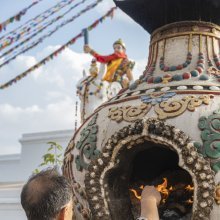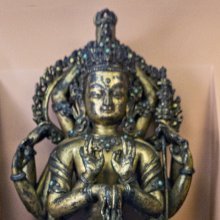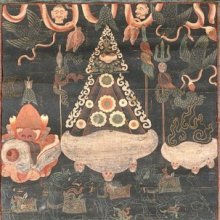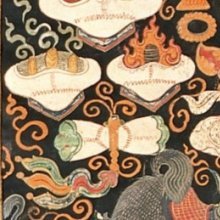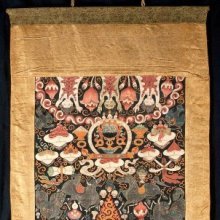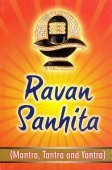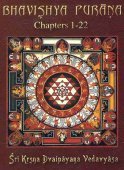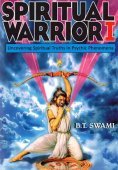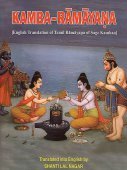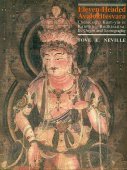Offering: 2 definitions
Introduction:
Offering means something in Buddhism, Pali, Hinduism, Sanskrit. If you want to know the exact meaning, history, etymology or English translation of this term then check out the descriptions on this page. Add your comment or reference to a book if you want to contribute to this summary article.
Images (photo gallery)
(+71 more images available)
In Hinduism
Natyashastra (theatrics and dramaturgy)
Source: Shodhganga: Elements of Art and Architecture in the Trtiyakhanda of the Visnudharmottarapurana (natya)1) Offering (oblations) is associated with Mukula-hasta: one of the twenty-two Single-hand Gestures (in Indian Dramas) (known as asaṃyuktahastas), according to the Viṣṇudharmottarapurāṇa, an ancient Sanskrit text which (being encyclopedic in nature) deals with a variety of cultural topics such as arts, architecture, music, grammar and astronomy.—The Viṣṇudharmottarapurāṇa suggests that the tips of all fingers of the hand should be joined together to make this posture. When the tips of all fingers are joined together, it makes a shape of a blooming bud. [...] The posture mukula-hasta is formed to show the activities like worshiping of deities and offering oblations. Moreover, to show the lotus flower this hand posture is suggested to be used in dance performance in the Viṣṇudharmottarapurāṇa.
2) Offering flowers (by entering in the stage) is associated with Āyata: one of the “three kinds of Standing Postures for Women”.—Standing postures are determined separately for male and female. In the Viṣṇudharmottarapurāṇa three kinds of standing postures are discussed for women. The āyata posture is used at the time of offering flowers by entering in the stage.

Natyashastra (नाट्यशास्त्र, nāṭyaśāstra) refers to both the ancient Indian tradition (shastra) of performing arts, (natya—theatrics, drama, dance, music), as well as the name of a Sanskrit work dealing with these subjects. It also teaches the rules for composing Dramatic plays (nataka), construction and performance of Theater, and Poetic works (kavya).
In Buddhism
Tibetan Buddhism (Vajrayana or tantric Buddhism)
Source: Google Books: The Crystal Mirror of Philosophical SystemsOffering refers to one of the “Seven Limbs” (i.e., the “seven aspects of ritual offering that are crucial to meditation in Mahāyāna Buddhism).—The essence of the Chö instruction is practice of the perfection of wisdom that is in conformity with mantra. [...] The four causes stated are: abiding in the empty, not letting go of sentient beings, doing as they are told, and being blessed by the Sugatas. [...] The third cause is relying on a virtuous friend, the root of the path; and the fourth is going for refuge, visualizing the field of assembly, the Seven Limbs [e.g., offering], and offering the mandala. These two are the preliminaries to the practice of pacification Chö.

Tibetan Buddhism includes schools such as Nyingma, Kadampa, Kagyu and Gelug. Their primary canon of literature is divided in two broad categories: The Kangyur, which consists of Buddha’s words, and the Tengyur, which includes commentaries from various sources. Esotericism and tantra techniques (vajrayāna) are collected indepently.
See also (Relevant definitions)
Partial matches: Offering, Te.
Starts with: Water offering.
Query error!
Full-text (+4517): Naivedya, Bali, Homa, Balidana, Yajna, Bhutayajna, Upahara, Svaha, Ahuti, Argha, Puja, Balikarman, Arpaṇa, Pitriyajna, Arghya, Tambula, Nivedana, Havya, Shraddha, Vaishvadeva.
Relevant text
Search found 501 books and stories containing Offering, Offerings, The offering; (plurals include: Offerings, Offeringses, The offerings). You can also click to the full overview containing English textual excerpts. Below are direct links for the most relevant articles:
Manasara (English translation) (by Prasanna Kumar Acharya)
Chapter 8 - The Sacrificial offerings (balikarma)
Chapter 32 - The temples of attendant deities (parivāra)
Chapter 37 - The opening of the dwelling house (gṛha-praveśa)
Maha Buddhavamsa—The Great Chronicle of Buddhas (by Ven. Mingun Sayadaw)
Four Kinds of Offerings to the Sangha < [Chapter 6 - On Pāramitā]
Seven Kinds of Gifts to the Sangha (Saṅghika-dāna) < [Chapter 6 - On Pāramitā]
Miscellaneous Notes on Different Aspect of Dāna (generosity) < [Chapter 6 - On Pāramitā]
Bharadvaja-srauta-sutra (by C. G. Kashikar)
Manusmriti with the Commentary of Medhatithi (by Ganganatha Jha)
Verse 11.119 < [Section XII - Expiation for the Immoral Religious Student (avakīrṇa)]
Verse 3.168 < [Section VIII - Śrāddhas]
Verse 3.91 < [Section VII - Duties of the Householder]
Guhyagarbha Tantra (with Commentary) (by Gyurme Dorje)
Text 18.6 (Commentary) < [Chapter 18 (Text And Commentary)]
Text 18.2 (Commentary) < [Chapter 18 (Text And Commentary)]
Text 18.3 (Commentary) < [Chapter 18 (Text And Commentary)]
The Bhikkhus Rules (by Bhikkhu Ariyesako)
On The Dais < [Part 6 - A Thai Wat In Australia]
Offering Daana Other Than Food < [Part 6 - A Thai Wat In Australia]
How To Make An Offering < [Chapter 3 - Possessions And Offerings]
Related products
(+3 more products available)

